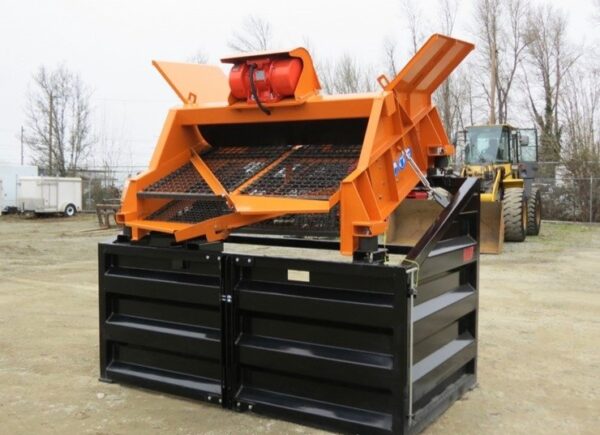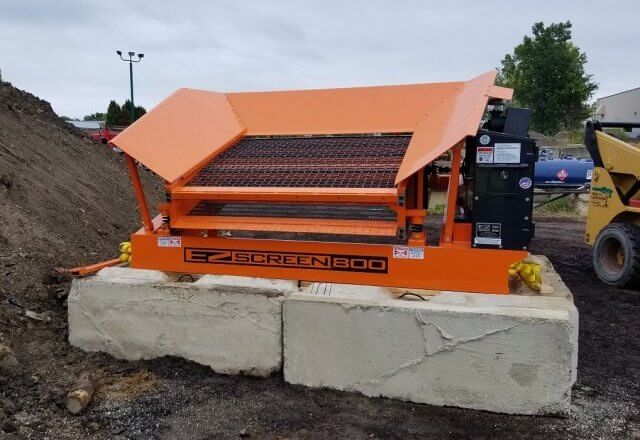Enhance Material Recuperation With State-Of-The-Art Dirt Screens for Recycling Facilities
In today's globe, where ecological sustainability is a pushing concern, reusing facilities play a crucial function in reducing waste and conserving sources. Making best use of product recuperation can be a complicated procedure, often hindered by the presence of dust and particles in the reusing stream. This is where advanced dirt displays come right into play, offering an encouraging service to enhance product recuperation prices. By effectively dividing undesirable contaminants, these innovative displays hold the prospective to reinvent reusing centers' procedures. But just how specifically do dust screens boost product recuperation? What are the crucial attributes that make them cutting edge? And how can reusing centers implement them successfully? In this discussion, we will check out the solution to these questions and look into real-life study that highlight the successful integration of dirt screens in reusing centers. Prepare to find the transformative power of state-of-the-art dust displays and their influence on enhancing material healing.
The Importance of Dirt Screens in Recycling Facilities
Dust displays play a vital duty in recycling centers by effectively dividing dust and other contaminants from recyclable materials. These displays, also referred to as trommel screens, are made to efficiently remove undesirable debris and guarantee that only tidy and functional products are refined further.
The primary feature of dirt screens is to separate larger pieces of dust, rocks, and various other non-recyclable items from the stream of materials. By doing so, they avoid these impurities from entering the recycling procedure and possibly damaging tools or endangering the quality of the end product.
In addition, dirt displays aid to enhance the general effectiveness of reusing procedures. By getting rid of dirt and various other contaminants early in the process, the screens reduce the amount of hand-operated labor called for to arrange and cleanse the products later on. This not just conserves time but also minimizes costs and raises efficiency.
Furthermore, making use of dirt displays adds to environmental sustainability. By making certain that uncontaminated and just clean products are processed, recycling centers can generate higher-quality recycled products. This, consequently, encourages making use of recycled materials in different markets, reducing the demand for virgin sources and lessening the environmental effect of resource removal and manufacturing procedures.
Just How Dirt Screens Improve Material Healing
Utilizing dust displays in reusing facilities substantially improves the procedure of material recovery. These screens play a vital role in dividing dust, debris, and various other undesirable products from the recyclable stream, causing enhanced performance and better outcome.
One of the major methods in which dust screens boost material recovery is by getting rid of impurities that can prevent the reusing procedure. Dirt, rocks, and other non-recyclable items can trigger damage to tools, reduce the performance of succeeding sorting processes, and contaminate the last recycled products. By properly screening out these contaminants, dust displays assist ensure that the recyclable materials stay pure and of top quality.
Additionally, dust displays make it possible for recycling facilities to recover a greater quantity of beneficial materials. By removing dust and debris, the screens permit for a much more accurate arranging process, enhancing the recovery rate of recyclable products. This means that more useful resources can be recovered and reused, lowering the demand for virgin products and minimizing the ecological effect associated with their removal and manufacturing.
Along with enhancing material healing, dust screens additionally add to the overall performance of reusing centers. By preventing equipment damage and decreasing downtime created by clogs and obstructions, these screens assist maintain a undisturbed and smooth recycling process. This boosted efficiency translates into cost financial savings and enables greater throughput, inevitably improving the productivity and sustainability of reusing operations.
Key Functions of State-of-the-Art Dirt Screens
To further boost the efficiency and efficiency of product healing in recycling facilities, state-of-the-art dust displays are geared up with essential functions that maximize the separation procedure and guarantee the greatest top quality outcome (dirt screen for sale). These have a peek at this website features consist of sophisticated testing technology, customizable setups, and durable construction
One secret feature of cutting edge dust displays is their advanced screening technology. These displays are designed with precision-engineered mesh or perforated plates that successfully different dust and particles from the recyclable materials. The size and spacing of the openings in the displays can be customized to fit different sorts of products, permitting effective splitting up and optimum recovery rates.
One more important attribute of these dirt displays is their personalized settings. Recycling centers can change the rate, angle, and amplitude of the screens to enhance the splitting up process. This versatility allows drivers to make improvements the displays according to the specific needs of the materials being processed, causing boosted precision and greater healing rates.
Additionally, state-of-the-art dirt screens are built with durable construction to hold up against the extreme problems of reusing facilities. They are made from resilient products such as stainless steel or high-strength alloys, making sure long life and marginal downtime because of upkeep or fixings. Furthermore, these displays are made with simple accessibility for cleansing and upkeep, helping with reliable operations and decreasing downtime.
Actions to Implementing Dust Screens in Recycling Facilities
What are the necessary actions for incorporating dirt screens into reusing centers? Implementing dirt displays in reusing centers includes an organized approach to ensure effective installment and procedure. The adhering to are the necessary steps to efficiently integrate dust displays:
Evaluation: Conduct a thorough assessment of the facility's needs and demands to identify the ideal dust display specifications. Think about factors such as product kind, volume, and preferred splitting up efficiency.

Setup: Prepare the facility for the setup of the dust displays. Follow maker standards and guarantee appropriate alignment and assimilation with the recycling process.
Checking and Calibration: Once the dust displays are more information mounted, perform detailed screening to guarantee proper performance. dirt screen for sale. Adjust the system to attain preferred separation performance and lessen worldly loss
Training and Upkeep: Train staff on operating and preserving the dirt screen system. Establish a normal upkeep schedule, including cleansing and examination, to make sure ideal efficiency and durability.

Case Researches: Effective Product Recuperation With Dust Screens
Integrating dirt screens into reusing centers has actually shown to be a successful technique for accomplishing efficient product recuperation, as demonstrated by numerous instance researches. These study highlight the favorable impact of dust displays on the general recycling procedure.
By applying dust screens, the facility was able to dramatically lower the amount of contamination in their recyclable products. The introduction of dirt screens likewise assisted to reduce the wear and tear on arranging devices, minimizing maintenance prices and downtime.
Another study showcases a country recycling facility that battled with excessive dirt and particles in their incoming waste stream. By mounting dust screens, the facility had the ability to eliminate a huge portion of the unwanted products, causing cleaner recyclables and enhanced performance in the arranging process. This caused greater material recuperation prices and reduced waste sent out to the garbage dump.
These study show that integrating dirt screens right into recycling centers can have a considerable positive effect on material healing. By properly removing dirt, particles, and other contaminants, reusing facilities can boost their general recycling rates, lower garbage dump waste, and maximize the value of recovered materials.
Final Thought
In conclusion, using advanced dirt displays in recycling centers is critical for enhancing material recuperation. These displays efficiently eliminate dirt and particles, permitting the effective separation and recovery of beneficial products. By implementing dust displays, recycling facilities can considerably boost their reusing procedures and add to a more sustainable future.
One of the main ways in which Your Domain Name dirt screens boost product recuperation is by eliminating contaminants that can hinder the recycling procedure. By successfully screening out these contaminants, dust displays aid guarantee that the recyclable products continue to be pure and of high quality.
Furthermore, dirt screens enable reusing facilities to recover a better amount of important products.In addition to boosting product recuperation, dirt screens likewise contribute to the total performance of recycling centers.In conclusion, the use of state-of-the-art dirt screens in recycling facilities is vital for boosting material healing.